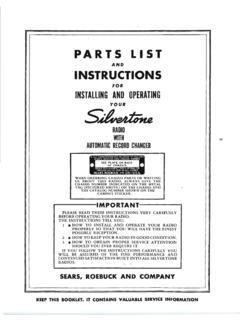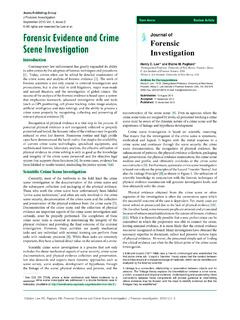Transcription of Job Market Signaling Michael Spence The Quarterly Journal ...
1 Job Market Signaling Michael Spence The Quarterly Journal of Economics, Vol. 87, No. 3. (Aug., 1973), pp. 355-374. Stable URL: The Quarterly Journal of Economics is currently published by The MIT Press. Your use of the JSTOR archive indicates your acceptance of JSTOR's Terms and Conditions of Use, available at JSTOR's Terms and Conditions of Use provides, in part, that unless you have obtained prior permission, you may not download an entire issue of a Journal or multiple copies of articles, and you may use content in the JSTOR archive only for your personal, non-commercial use.
2 Please contact the publisher regarding any further use of this work. Publisher contact information may be obtained at Each copy of any part of a JSTOR transmission must contain the same copyright notice that appears on the screen or printed page of such transmission. The JSTOR Archive is a trusted digital repository providing for long-term preservation and access to leading academic journals and scholarly literature from around the world. The Archive is supported by libraries, scholarly societies, publishers, and foundations. It is an initiative of JSTOR, a not-for-profit organization with a mission to help the scholarly community take advantage of advances in technology.
3 For more information regarding JSTOR, please contact Thu Apr 3 07:17:58 2008. JOB Market Signaling *. 1. Introduction, 355. - 2. Hiring as investment under uncertainty, 356. - 3. Applicant Signaling , 358. -4. Informational feedback and the definition of equilibrium, 359. - 5. Properties of informational equilibria: an example, 361. - 6. The informational impact of indices, 368. - Conclusions, 374. The term " Market Signaling " is not exactly a part of the well- defined, technical vocabulary of the economist. As a part of the preamble, therefore, I feel I owe the reader a word of explanation about the title.
4 I find it difficult, however, to give a coherent and comprehensive explanation of the meaning of the term abstracted from the contents of the essay. I n fact, it is part of my purpose to outline a model in which Signaling is implicitly defined and to ex- plain why one can, and perhaps should, be interested in it. One might accurately characterize my problem as a Signaling one, and that of the reader, who is faced with an investment decision under uncertainty, as that of interpreting signals. How the reader interprets my report of the content of this essay will depend upon his expectation concerning my stay in the Market .
5 If one believes I will be in the essay Market repeatedly, then both the reader and I will contemplate the possibility that I might invest in my future ability to communicate by accurately reporting the content of this essay now. On the other hand, if I am to be in the Market only once, or relatively infrequently, then the above-men- tioned possibility deserves a low probability. This essay is about markets in which Signaling takes place and in which the primary signalers are relatively numerous and in the Market sufficiently in- frequently that they are not expected to (and therefore do not) in- vest in acquiring Signaling reputations.
6 * T h e essay is based on the author's doctoral dissertation (" Market Signalling: The Informational Structure of Job Markets and Related Phe- nomcna," thesis, Harvard University, 1972), forthcoming as a book en- titled Market Signaling : Information Transfer i n Hiring and Related Screening Processes in the Harvard Economic Studies Series, Harvard University Press. The aim here is to present the outline of the Signaling model and some of its conclusions. Generalizations of the numerical examples used for expositional purposes here are found in ibid.
7 And elsewhere. I owe many people thanks for help in the course of the current study, too many to mention all. However, I should acknowledge explicitly the mag- nitude of my debts to Kenneth Arrow and Thomas Schelling for persistently directing my attention to new and interesting problems. 356 Q U A R T E R L Y J O U R N A L OF E C O N O M I C S. I shall argue that the paradigm case of the Market with this type of informational structure is the job Market and will therefore focus upon it. By the end I hope it will be clear (although space limitations will not permit an extended argument) that a consider- able variety of Market and quasi- Market phenomena like admissions procedures, promotion in organizations, loans and consumer credit, can be usefully viewed through the conceptual lens applied to the j oh Market .
8 If the incentives for veracity in reporting anything by means of a conventional Signaling code are weak, then one must look for other means by which information transfers take place. My aim is to outline a conceptual apparatus within which the Signaling power of education, job experience, race, sex, and a host of other observ- able, personal characteristics can be determined. The question, put crudely, is what in the interactive structure of a Market accounts for the informational content, if any, of these potential signals. I. have placed primary emphasis upon (i) the definition and properties of Signaling equilibria, (ii) the interaction of potential signals, and (iii) the allocative efficiency of the Market .
9 In most job markets the employer is not sure of the productive capabilities of an individual a t the time he hires Nor will this information necessarily become available to the employer im- mediately after hiring. The job may take time to learn. Often specific training is required. And there may be a contract period within which no recontracting is allowed. The fact that it takes time to learn an individual's productive capabilities means that hiring is an investment decision. The fact that these capabilities are not known beforehand makes the decision one under uncertainty.
10 T o hire someone, then, is frequently to purchase a 10ttery.~In what follows, I shall assume the employer pays the certain mone- tary equivalent of the lottery to the individual as If he is 1. There are, of course, other informational gaps in the job Market . Just a;r employers have less than perfect information about applicants, so also will applicants be imperfectly informed about the qualities of jobs and work en- vironmenks. And in a different vein neither potential employees nor employers know all of the people in the Market .







